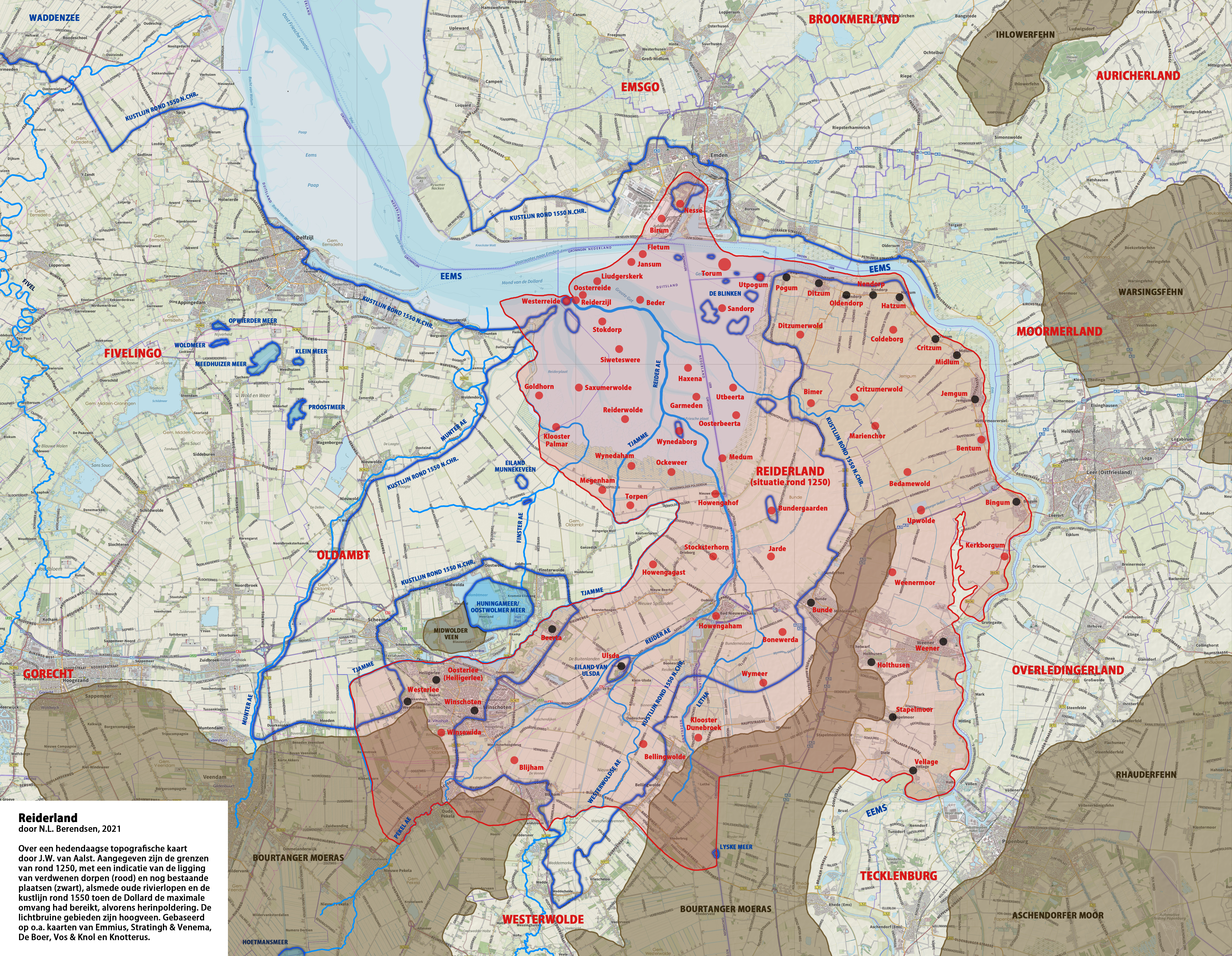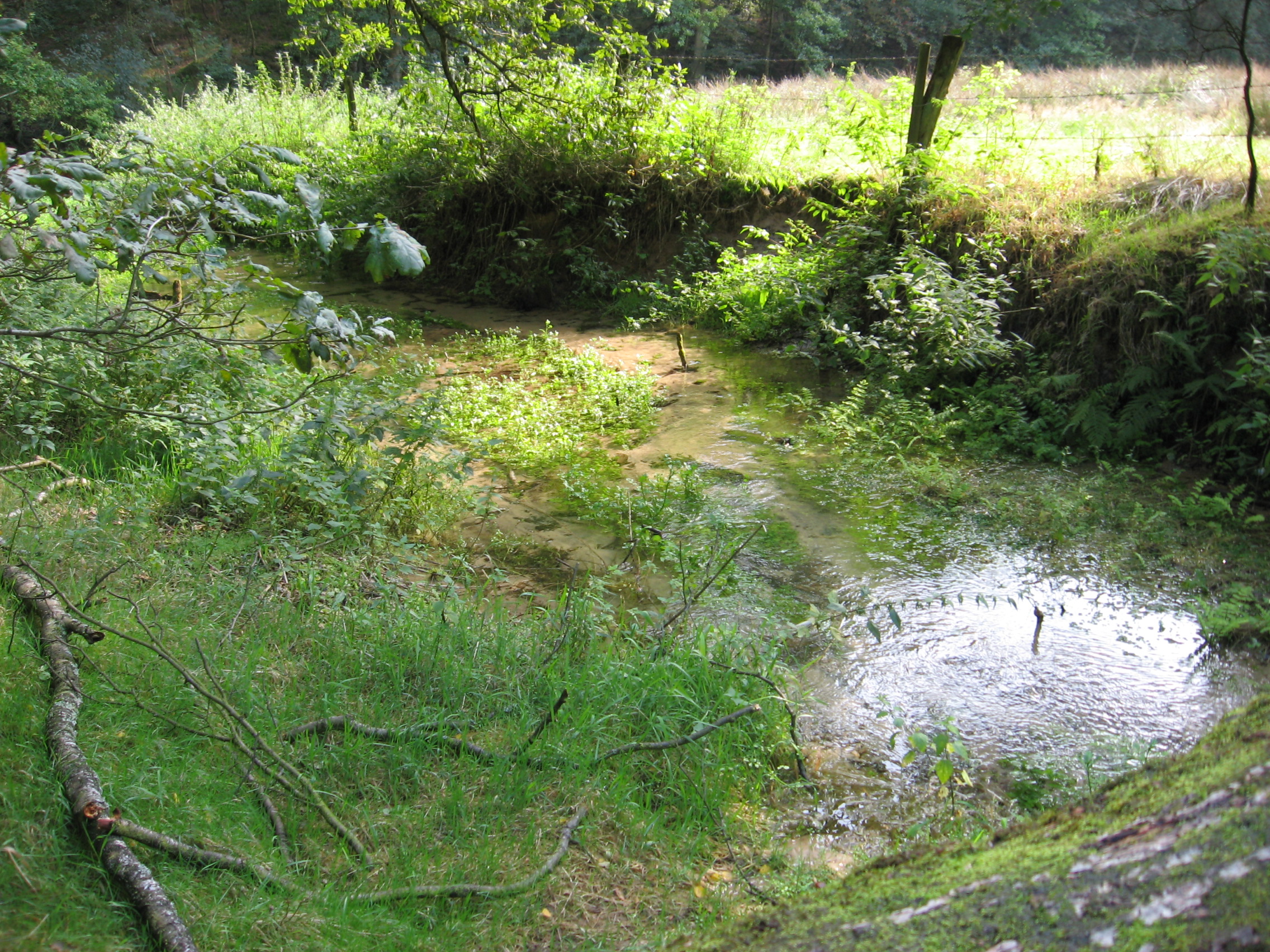|
Rheiderland
The Rheiderland is a region of Germany and the Netherlands between the River Ems and the Bay of Dollart. The German part of the Rheiderland lies in East Frisia, west of the Ems. The Dutch part (written: ''Reiderland'') lies in the Dutch province of Groningen and is mostly part of Oldambt. The Rheiderland is one of the four historic regions on the mainland in the district of Leer; the others being the Overledingerland, the Moormerland and the Lengenerland. Nature The Rheiderland consists largely of marshland ( polder) and is as flat as the rest of East Frisia, but there are fewer trees. As a result the view is generally clear as far as the horizon. Along the River Ems are the historic river marshes, down to 1.50 metres below sea level. Numerous birds breed on the damp and wet meadows including the peewit, black-tailed godwit and redshank. In winter up to 120,000 wild geese forage here (especially the greater white-fronted goose, barnacle goose and greylag goose). The gr ... [...More Info...] [...Related Items...] OR: [Wikipedia] [Google] [Baidu] |
Rheiderland
The Rheiderland is a region of Germany and the Netherlands between the River Ems and the Bay of Dollart. The German part of the Rheiderland lies in East Frisia, west of the Ems. The Dutch part (written: ''Reiderland'') lies in the Dutch province of Groningen and is mostly part of Oldambt. The Rheiderland is one of the four historic regions on the mainland in the district of Leer; the others being the Overledingerland, the Moormerland and the Lengenerland. Nature The Rheiderland consists largely of marshland ( polder) and is as flat as the rest of East Frisia, but there are fewer trees. As a result the view is generally clear as far as the horizon. Along the River Ems are the historic river marshes, down to 1.50 metres below sea level. Numerous birds breed on the damp and wet meadows including the peewit, black-tailed godwit and redshank. In winter up to 120,000 wild geese forage here (especially the greater white-fronted goose, barnacle goose and greylag goose). The gr ... [...More Info...] [...Related Items...] OR: [Wikipedia] [Google] [Baidu] |
Jemgum
Jemgum is a municipality in the Leer district, in the northwest of Lower Saxony, Germany. The area is known as ''Rheiderland'' (German) or ''Reiderland'' (Dutch). Rheiderland is located in East Friesland. The East Friesland area of Germany (also known in English as East Frisia) is home to German writers Georg Klein (Bunde) and Uwe Kreisel (Jemgum). History Jemgum was the site of the Battle of Jemmingen on 21 July 1568, an early event of the Eighty Years' War, in which a Spanish army defeated a Dutch Rebel army under Louis of Nassau Louis of Nassau (Dutch: Lodewijk van Nassau, January 10, 1538 – April 14, 1574) was the third son of William I, Count of Nassau-Siegen and Juliana of Stolberg, and the younger brother of Prince William of Orange Nassau. Louis was a key .... References Populated places established in the 8th century Towns and villages in East Frisia Leer (district) Rheiderland {{Leer-geo-stub ... [...More Info...] [...Related Items...] OR: [Wikipedia] [Google] [Baidu] |
Weener
Weener () is a town in the district of Leer, in Lower Saxony, Germany. It is situated near the border with the Netherlands, on the river Ems. The towns population is at 15,654, making it the largest town of the region Rheiderland. It has a railway and autobahn connection to Groningen, Netherlands, Emden and Bremen. The city was first mentioned in a monastery's records in 951. Town Division of the town The town of Weener consists of 9 districts: * Weener * Kirchborgum * Diele * Vellage / Halte * Stapelmoor * Holthusen * Weenermoor / Möhlenwarf * St. Georgiwold * Beschotenweg Neighbouring communities In the district of Leer: * Bunde * Leer * Jemgum * Westoverledingen In the district of Emsland: * Papenburg * Rhede Politics Mayor *2006–2014: Wilhelm Dreesmann *2014–2021: Ludwig Sonnenberg *2021–incumbent: Heiko Abbas Town Council The last election to the town council took place in 2006: * SPD = 53,0%, 17 seats * CDU = 19,6%, 6 seats * UWG = 19,0%, 6 seats * Grü ... [...More Info...] [...Related Items...] OR: [Wikipedia] [Google] [Baidu] |
East Frisia
East Frisia or East Friesland (german: Ostfriesland; ; stq, Aastfräislound) is a historic region in the northwest of Lower Saxony, Germany. It is primarily located on the western half of the East Frisian peninsula, to the east of West Frisia and to the west of Landkreis Friesland. Administratively, East Frisia consists of the districts Aurich, Leer and Wittmund and the city of Emden. It has a population of approximately 469,000 people and an area of . There is a chain of islands off the coast, called the East Frisian Islands (''Ostfriesische Inseln''). From west to east, these islands are: Borkum, Juist, Norderney, Baltrum, Langeoog and Spiekeroog. History The geographical region of East Frisia was inhabited in Paleolithic times by reindeer hunters of the Hamburg culture. Later there were Mesolithic and Neolithic settlements of various cultures. The period after prehistory can only be reconstructed from archaeological evidence. Access to the early history of East Fris ... [...More Info...] [...Related Items...] OR: [Wikipedia] [Google] [Baidu] |
Bunde, Germany
Bunde is a municipal district in East Frisia, in Lower Saxony, Germany, about south of Emden, Germany, and east of Groningen, Netherlands. It lies on the southern tip of the Dollart, a bay of the North Sea between Germany and the Netherlands, and has a land border with the Netherlands. Bunde is among the smaller districts of East Frisia, with a population of 7,607 (as of 2015). About half live in the town of Bunde itself. The district's population density is comparatively low at , compared with for Germany as a whole. In the 17th and 18th centuries, sizeable areas of the district were wrested from the sea by the creation of polders. Bunde's economy centers on agriculture and tourism. The community has been officially recognized as a resort town since 1998. Many of the town's residents commute to jobs elsewhere, notably in Leer, about to the east. Residents include a number of Dutch nationals, most of whom commute to jobs in the Netherlands. The town's cultural artifacts inc ... [...More Info...] [...Related Items...] OR: [Wikipedia] [Google] [Baidu] |
Reiderland Kaart
Reiderland () is a former municipality in the province Groningen in the northeastern Netherlands, which was founded in 1990 during a large municipal reorganisation. The former municipalities Finsterwolde and Bad Nieuweschans were abolished and added to Beerta. In 1992, the new municipality was given its current name. In 2010 it joined in the municipality Oldambt. Politics Reiderland was one of the few municipalities in the Netherlands that still had communist councillors after the dissolution of the Communist Party of the Netherlands in 1989. (As of 2006, it was one of only four Dutch municipalities to have any, the other three being Heiloo, Scheemda and Lemsterland.) The New Communist Party of the Netherlands was in fact the largest party in Reiderland from 1990 to 1998 and again from 2002 to 2006. Finsterwolde and Beerta, which was the only town in the Netherlands that ever had a communist mayor, had long been communist strongholds. In the 1998 municipal election, the New Comm ... [...More Info...] [...Related Items...] OR: [Wikipedia] [Google] [Baidu] |
Groningen (province)
Groningen (; gos, Grunn; fry, Grinslân) is the northeasternmost province of the Netherlands. It borders on Friesland to the west, Drenthe to the south, the German state of Lower Saxony to the east, and the Wadden Sea to the north. As of February 2020, Groningen had a population of 586,309 and a total area of . Historically the area was at different times part of Frisia, the Frankish Empire, the Holy Roman Empire, and the Dutch Republic, the precursor state of the modern Netherlands. In the 14th century, the city of Groningen became a member of the Hanseatic League. The provincial capital and the largest city in the province is the city of Groningen (231,299 inhabitants). Since 2016, René Paas has been the King's Commissioner in the province. A coalition of GroenLinks, the Labour Party, ChristianUnion, People's Party for Freedom and Democracy, Democrats 66, and Christian Democratic Appeal forms the executive branch. The province is divided into 10 municipalities. T ... [...More Info...] [...Related Items...] OR: [Wikipedia] [Google] [Baidu] |
Eurasian Golden Plover
The European golden plover (''Pluvialis apricaria''), also known as the European golden-plover, Eurasian golden plover, or just the golden plover within Europe, is a largish plover. This species is similar to two other golden plovers: the American golden plover, ''Pluvialis dominica'', and Pacific golden plover, ''Pluvialis fulva'', which are both smaller, slimmer and relatively longer-legged than European golden plover, and both have grey rather than white axillary feathers (only properly visible in flight). Taxonomy The European golden plover was formally described by the Swedish naturalist Carl Linnaeus in 1758 in the tenth edition of his '' Systema Naturae''. He placed it with the other plovers in the genus ''Charadrius'' and coined the binomial name ''Charadrius apricarius''. The species is now placed in the genus ''Pluvialis'' that was introduced in 1760 by the French zoologist Mathurin Jacques Brisson. The genus name is Latin and means "relating to rain", from ''pluvia ... [...More Info...] [...Related Items...] OR: [Wikipedia] [Google] [Baidu] |
Netherlands
) , anthem = ( en, "William of Nassau") , image_map = , map_caption = , subdivision_type = Sovereign state , subdivision_name = Kingdom of the Netherlands , established_title = Before independence , established_date = Spanish Netherlands , established_title2 = Act of Abjuration , established_date2 = 26 July 1581 , established_title3 = Peace of Münster , established_date3 = 30 January 1648 , established_title4 = Kingdom established , established_date4 = 16 March 1815 , established_title5 = Liberation Day (Netherlands), Liberation Day , established_date5 = 5 May 1945 , established_title6 = Charter for the Kingdom of the Netherlands, Kingdom Charter , established_date6 = 15 December 1954 , established_title7 = Dissolution of the Netherlands Antilles, Caribbean reorganisation , established_date7 = 10 October 2010 , official_languages = Dutch language, Dutch , languages_type = Regional languages , languages_sub = yes , languages = , languages2_type = Reco ... [...More Info...] [...Related Items...] OR: [Wikipedia] [Google] [Baidu] |
Ems (river)
The Ems (german: Ems; nl, Eems) is a river in northwestern Germany. It runs through the states of North Rhine-Westphalia and Lower Saxony, and discharges into the Dollart Bay which is part of the Wadden Sea. Its total length is . The state border between the Lower Saxon area of East Friesland (Germany) and the province of Groningen (Netherlands), whose exact course was the subject of a border dispute between Germany and the Netherlands (settled in 2014), runs through the Ems estuary. Course The source of the river is in the southern Teutoburg Forest in North Rhine-Westphalia. In Lower Saxony, the brook becomes a comparatively large river. Here the swampy region of Emsland is named after the river. In Meppen the Ems is joined by its largest tributary, the Hase River. It then flows northwards, close to the Dutch border, into East Frisia. Near Emden, it flows into the Dollart bay (a national park) and then continues as a tidal river towards the Dutch city of Delfzijl. Betwee ... [...More Info...] [...Related Items...] OR: [Wikipedia] [Google] [Baidu] |
Wymeer
Wymeer is a village in the municipality of Bunde in the district of Leer in Lower Saxony, Germany Germany,, officially the Federal Republic of Germany, is a country in Central Europe. It is the second most populous country in Europe after Russia, and the most populous member state of the European Union. Germany is situated betwe .... Municipality of Bunde. Retrieved 25 May 2016. References Villages in Lower Saxony {{LowerSaxony-geo-stub ...[...More Info...] [...Related Items...] OR: [Wikipedia] [Google] [Baidu] |




_-_Ystad-2020.jpg)
